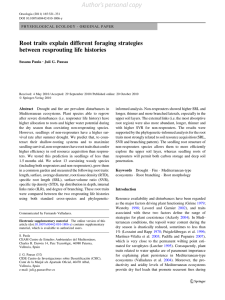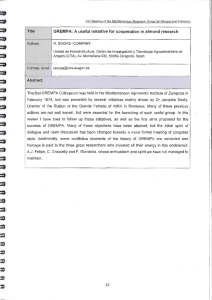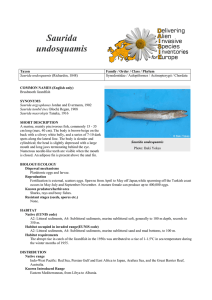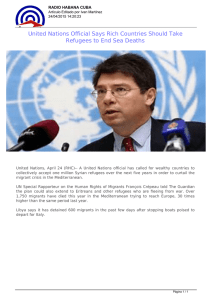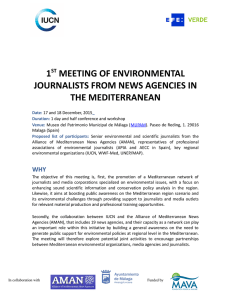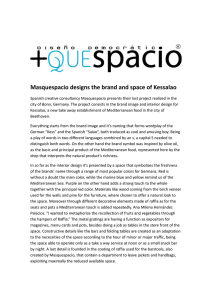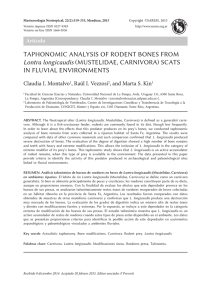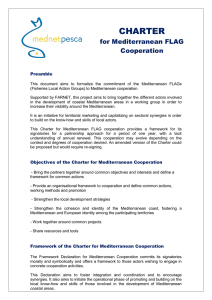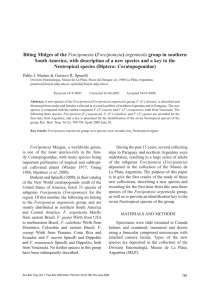FIRE AND RESPROUTING IN MEDITERRANEAN ECOSYSTEMS
Anuncio
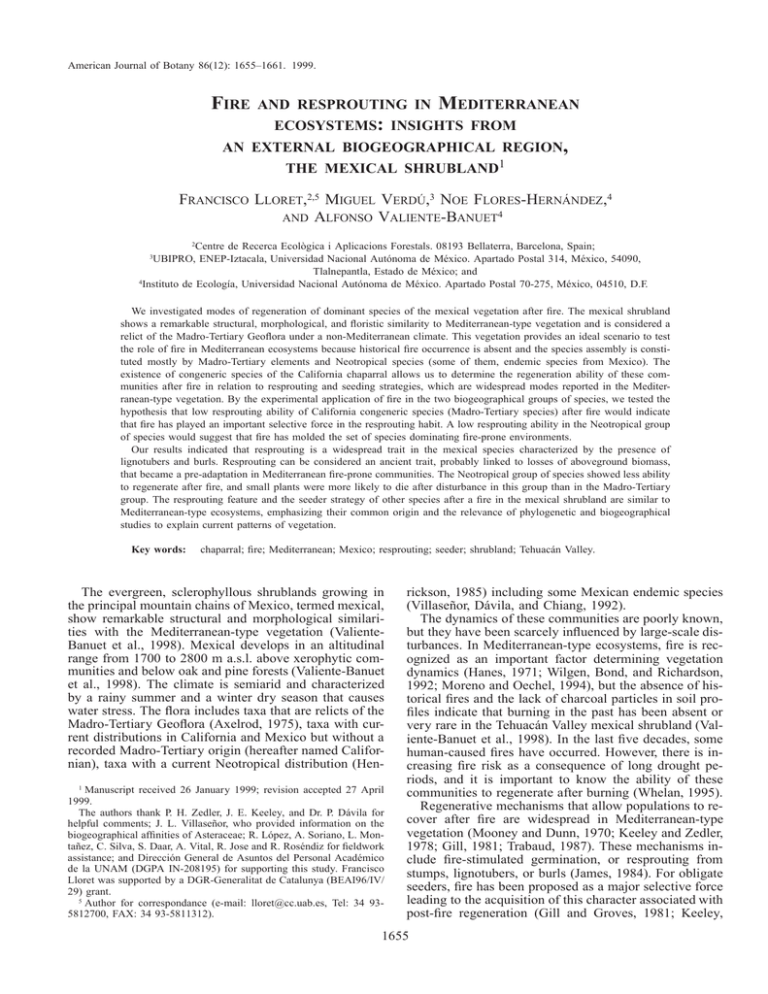
American Journal of Botany 86(12): 1655–1661. 1999. FIRE AND RESPROUTING IN MEDITERRANEAN ECOSYSTEMS: INSIGHTS FROM AN EXTERNAL BIOGEOGRAPHICAL REGION, THE MEXICAL SHRUBLAND1 FRANCISCO LLORET,2,5 MIGUEL VERDÚ,3 NOE FLORES-HERNÁNDEZ,4 AND ALFONSO VALIENTE-BANUET4 2Centre de Recerca Ecològica i Aplicacions Forestals. 08193 Bellaterra, Barcelona, Spain; UBIPRO, ENEP-Iztacala, Universidad Nacional Autónoma de México. Apartado Postal 314, México, 54090, Tlalnepantla, Estado de México; and 4Instituto de Ecologı́a, Universidad Nacional Autónoma de México. Apartado Postal 70-275, México, 04510, D.F. 3 We investigated modes of regeneration of dominant species of the mexical vegetation after fire. The mexical shrubland shows a remarkable structural, morphological, and floristic similarity to Mediterranean-type vegetation and is considered a relict of the Madro-Tertiary Geoflora under a non-Mediterranean climate. This vegetation provides an ideal scenario to test the role of fire in Mediterranean ecosystems because historical fire occurrence is absent and the species assembly is constituted mostly by Madro-Tertiary elements and Neotropical species (some of them, endemic species from Mexico). The existence of congeneric species of the California chaparral allows us to determine the regeneration ability of these communities after fire in relation to resprouting and seeding strategies, which are widespread modes reported in the Mediterranean-type vegetation. By the experimental application of fire in the two biogeographical groups of species, we tested the hypothesis that low resprouting ability of California congeneric species (Madro-Tertiary species) after fire would indicate that fire has played an important selective force in the resprouting habit. A low resprouting ability in the Neotropical group of species would suggest that fire has molded the set of species dominating fire-prone environments. Our results indicated that resprouting is a widespread trait in the mexical species characterized by the presence of lignotubers and burls. Resprouting can be considered an ancient trait, probably linked to losses of aboveground biomass, that became a pre-adaptation in Mediterranean fire-prone communities. The Neotropical group of species showed less ability to regenerate after fire, and small plants were more likely to die after disturbance in this group than in the Madro-Tertiary group. The resprouting feature and the seeder strategy of other species after a fire in the mexical shrubland are similar to Mediterranean-type ecosystems, emphasizing their common origin and the relevance of phylogenetic and biogeographical studies to explain current patterns of vegetation. Key words: chaparral; fire; Mediterranean; Mexico; resprouting; seeder; shrubland; Tehuacán Valley. The evergreen, sclerophyllous shrublands growing in the principal mountain chains of Mexico, termed mexical, show remarkable structural and morphological similarities with the Mediterranean-type vegetation (ValienteBanuet et al., 1998). Mexical develops in an altitudinal range from 1700 to 2800 m a.s.l. above xerophytic communities and below oak and pine forests (Valiente-Banuet et al., 1998). The climate is semiarid and characterized by a rainy summer and a winter dry season that causes water stress. The flora includes taxa that are relicts of the Madro-Tertiary Geoflora (Axelrod, 1975), taxa with current distributions in California and Mexico but without a recorded Madro-Tertiary origin (hereafter named Californian), taxa with a current Neotropical distribution (Hen1 Manuscript received 26 January 1999; revision accepted 27 April 1999. The authors thank P. H. Zedler, J. E. Keeley, and Dr. P. Dávila for helpful comments; J. L. Villaseñor, who provided information on the biogeographical affinities of Asteraceae; R. López, A. Soriano, L. Montañez, C. Silva, S. Daar, A. Vital, R. Jose and R. Roséndiz for fieldwork assistance; and Dirección General de Asuntos del Personal Académico de la UNAM (DGPA IN-208195) for supporting this study. Francisco Lloret was supported by a DGR-Generalitat de Catalunya (BEAI96/IV/ 29) grant. 5 Author for correspondance (e-mail: [email protected], Tel: 34 935812700, FAX: 34 93-5811312). rickson, 1985) including some Mexican endemic species (Villaseñor, Dávila, and Chiang, 1992). The dynamics of these communities are poorly known, but they have been scarcely influenced by large-scale disturbances. In Mediterranean-type ecosystems, fire is recognized as an important factor determining vegetation dynamics (Hanes, 1971; Wilgen, Bond, and Richardson, 1992; Moreno and Oechel, 1994), but the absence of historical fires and the lack of charcoal particles in soil profiles indicate that burning in the past has been absent or very rare in the Tehuacán Valley mexical shrubland (Valiente-Banuet et al., 1998). In the last five decades, some human-caused fires have occurred. However, there is increasing fire risk as a consequence of long drought periods, and it is important to know the ability of these communities to regenerate after burning (Whelan, 1995). Regenerative mechanisms that allow populations to recover after fire are widespread in Mediterranean-type vegetation (Mooney and Dunn, 1970; Keeley and Zedler, 1978; Gill, 1981; Trabaud, 1987). These mechanisms include fire-stimulated germination, or resprouting from stumps, lignotubers, or burls (James, 1984). For obligate seeders, fire has been proposed as a major selective force leading to the acquisition of this character associated with post-fire regeneration (Gill and Groves, 1981; Keeley, 1655 1656 AMERICAN JOURNAL 1986). The hypothesis of the adaptative significance of resprouting due to recurring fire (Mooney and Dunn, 1970; Biswell, 1974; Naveh, 1975; Shmida, 1981) has often been rejected because the resprouting habit is common among the dicotyledons (Wells, 1969), and several authors have proposed resprouting to be a pre-adaptative character resulting from anatomical features and recurrent losses of biomass, for example by herbivory pressures (Trabaud, 1987; Zedler and Zammit, 1989; López-Soria and Castell, 1992). An experimental study on the resprouting response to fire that considers the development stage of the plants and the biogeographical origin of the species may provide new supports for the last hypothesis. The effect of plant size on the resprouting response is important at the population dynamics level. If young, small plants are more likely to die than adult large ones (Rundel et al., 1987; Bradstock and Myerscough, 1988), high fire frequency will tend to deplete populations. This is because adult plants that die as a consequence of fire (Hanes, 1971) cannot be replaced during the periods between fire, unless high recruitment rates occur (Bradstock and Myerscough, 1988). Consequently, if high fire frequencies have operated as a selective force for resprouter species with low seedling establishment, a pronounced ability to resprout is expected to occur in both large and small plants (Schlesinger and Gill, 1980). The flora and historical pattern of fire in the mexical provide an opportunity to test ideas about the evolution of the life histories under selection by fire. Most of the dominant species growing in the mexical shrubland are long lived and have low seedling densities (A. Vital and A. Valiente-Banuet, unpublished data, Instituto de Ecologı́a, UNAM, México). The rarity of fire in the past and the traits of the species justify the assumption that the mexical shrubland may approximate the pre-fire selection state of shrub vegetation with a long history of burning. Further enhancing the comparison is the fact that many species of the mexical are in the same genera as California chaparral (Valiente-Banuet et al., 1998). The existence of these congeneric species of Californian resprouters in a presumptive pre-selection state allows the importance of fire as a selective force to be evaluated. Low resprouting ability of mexical congeneric resprouters after fire would be consistent with the hypothesis that resprouting ability is enhanced by fire selection, rather than simply inherited as a general capability. Vigorous resprouting in Neotropical species without paleohistorical record of high fire frequency would, in contrast, support the pre-adaptative hypothesis. A lower resprouting ability in the Neotropical group than in the congeneric species of Californian resprouters would suggest that fire may have selected the set of species dominating fire-prone environments, by favoring those taxa with greater ability to resprout. This study describes post-fire regeneration patterns, including both resprouting and germination, in a mexical shrubland located at the Tehuacán Valley (south-central México). We report the effects of fire and plant size on the survival and resprout biomass of four congeneric species of Californian resprouters and four species with Neotropical affinities by experimentally applying fire to individual plants. The specific objectives of the study were to: (1) identify the importance of the resprouting and the OF BOTANY [Vol. 86 seeder habits in the mexical community; (2) compare the resprouting ability between Madro-Tertiary (all of them are congeneric species of Californian resprouters) and Neotropical species; (3) evaluate the importance of plant size in the resprouting response of these species. MATERIALS AND METHODS Sampling in burned area—In June 1995, a wildfire burned ;2 ha of mexical shrubland in Cerro Viejo mountain (Mexico, Tehuacán Valley, 188159 N, 978269 W; 2450 m a.s.l.). In April 1997, five 25 3 2 m transects were established and all stump diameters of dead and resprouting plants for each species were measured. Seedling density of seeder species was also evaluated. Four 25-m lineal transects were established in adjacent unburned stands, and species cover was estimated by the point-intercept method by recording the occurrence of species canopies as points at each 0.5 m. An accurate description of the climate in the Tehuacán Valley, as well as the structure and the species composition of the mexical shrubland of the region, has been given by Valiente-Banuet et al. (1998). Burning experiment—At the end of the 1997 drought season (April), we selected 24 plants of eight dominant species growing in a mexical shrubland located at Cerro Zotoltepec (Mexico, Tehuacán Valley, 188389 N, 978279 W; 2350 m a.s.l.). Four of these species [Quercus sebifera Trel., Rhus standleyi Barkley, Garrya ovata Benth., and Comarostaphylis polifolia (Kunth) Zucc. ex Klotzsch subsp. polifolia] are relict genera of the Madro-Tertiary Geoflora with close relatives in the Californian chaparral that are able to resprout after fire (Axelrod, 1975; Valiente-Banuet et al., 1998). The other four species, Xerospirea hartwegiana (Rydb.) Henr., Coutaportla ghiesbreghtiana (Baill.) Urb., Mortonia diffusa Rose & Standl.; and Krameria cytisoides Cav., have Neotropical affinities (Rzedowski, 1968; Gentry, 1982; Henrickson, 1985; Mabberley, 1997). The criteria used to select these species were: 1—to have a similar growth form (shrubs), 2—to be dominant in the community, and 3—to exist reliable information about its biogeographical origin. All species, except Mortonia diffusa, were also present in the Cerro Viejo mountain (burned area) (Flores-Hernández, 1996), though their abundance in the proximity of the burned area may not reflect their abundance in the entire locality. The selected plants covered all the size ranges present in the community. To balance the design, three groups of plants (small—volume , 50 dm3, medium—volume between 50 and 250 dm3, and large— volume . 250 dm3), with the same number of plants were selected for each species. Fire treatments (flame application and control) were randomly assigned to half of the plants of each group. Plant size before fire was estimated by measuring the canopy projection, assuming an ellipsoidal shape, and the total basal area of the shoots. All the shoots of each plant were clipped, and the soil surface was cleared in order to expose the stump. The surface of each stump was also estimated from two perpendicular diameters. Fire was applied to the stumps with the flame of a propane torch as described by Lloret and Lopez-Sória (1992). The range of temperatures (3008–4008C) and the duration of treatments (3 min) were chosen according to measurements taken from wildfires in Mediterranean shrublands (Trabaud, 1979). Control plants were submitted to the same clipping procedure, but without applying heat. Each stump was covered by a wire mesh to prevent vertebrate herbivory. At the end of the rainy season during October of 1997, the number and biomass (dry mass) of resprouts for each plant were estimated directly by harvesting all their resprouts. Some individuals were lost through accidental causes, and they were not included in the analysis. Survival was analyzed following the JMP 2.0.5 procedure (SAS Institute, 1989) by a logistic regression in which main sources were fire, biogeographic group (fixed factors), and species (random factor) nested within biogeographic group. The interaction between fire and biogeographic group was also estimated. The effect of plant size and fire on 9.8 6 2.7 0.6 6 0.6 ,0.1 6 ,0.1 — 1.6 6 1.3 0.5 6 0.4 0.5 6 0.5 1.8 6 1.8 31.7 6 6.0 6.9 6 2.9 0.2 6 0.2 1.5 6 1.0 5.6 6 1.5 2.2 6 2.2 1.2 6 1.2 — — — — 6 0.7 6 ,0.1 6 0.5 6 ,0.1 6 ,0.1 — 0.7 6 0.7 0.9 6 0.7 5.8 6 1.1 3.1 6 1.2 2.1 6 1.2 1.7 6 0.9 0.4 6 0.3 1.4 6 0.7 0.1 6 0.1 ,0.1 6 ,0.1 1.1 6 0.7 ,0.1 6 ,0.1 4.7 6 2.0 — — — — — — — 0.35 — 0.99 0.50 0.92 — 0.33 — — — — 0.20 76.9 (39) Yes 32.1 (28) Yes 0 0 60.0 (15) Yes 85.2 (277) Yes Yes Yes 83.9 (62) 0 81.2 (16) 75.0 (20) 80.0 (5) Yes Yes Lignotuber Lignotuber Root crown No No No Lignotuber No Lignotuber No No No No No Lignotuber Lignotuber Lignotuber Lignotuber No Madro-Tertiary Madro-Tertiary Neotropical Neotropical Mexican Mexican Madro-Tertiary Californian Madro-Tertiary Californian Californian Californian Neotropical Madro-Tertiary Madro-Tertiary Neotropical Neotropical Neotropical Neotropical Anacardiaceae Anacardiaceae Asteraceae Asteraceae Asteraceae Asteraceae Ericaceae Euphorbiaceae Fagaceae Lamiaceae Lamiaceae Lamiaceae Mimosaceae Rhamnaceae Rosaceae Rosaceae Rosaceae Rosaceae Phytolacaceae Rhus standleyi Rhus virens Ageratina spinosarum Gochnatia smithii Gymnosperma glutinosa Stevia salicifolia Comarostaphylis polifolia Croton hypoleucus Quercus sebifera Salvia aspera Salvia candida Salvia thymoides Havardia elachystophylla Ceanothus greggii Amelanchier denticulata Xerospirea hartwegiana Citharexylum oleinum Lindleya mespilioides Phytolacca icosandra Biogeographical affinity 6.3 ,0.1 0.5 ,0.1 ,0.1 Mean cover (%) 6 SE Mean cover (%) 6 SE Resprouting % (n) Seedling density (no./m2) Unburned transects 1657 Family Most species growing in the Mexical shrubland were able to resprout after fire (Table 1). The percentage of resprouting plants ranged from 32.1% in Ageratina spinosarum to 85.2% in Quercus sebifera. In several cases, we could assess that the species was able to survive a fire, but we could not obtain a reliable percentage of resprouting plants because of small sample sizes. The number of species that produced seedlings after fire was lower (Ceanothus greggii, Salvia aspera, S. candicans, S. thymoides, Croton hypoleucus, and Phytolacca icosandra), and the number of seedlings per square metre ranged from 0.20 (P. icosandra) to 0.99 (S. aspera). Except for C. greggii, all of these seeder species are able to resprout as well. Two years after fire, the percentage of ground covered by seeder species (;14%) was similar to that covered by resprouters (;15%). In unburned areas, however, the ground cover of resprouters (;60%; Q. sebifera, R. standleyi, R. virens, and C. polifolia) was much greater than the ground cover of seeders (;25%). All eight species that were experimentally burned successfully resprouted after fire (Table 2). When analyzing all species together, heat application decreased this resprouting ability (Wald x2 5 11.17, df 5 1, P , 0.001), but the significant interaction between biogeographical group and fire (Wald x2 5 5.66, df 5 1, P 5 0.017) indicates that the ability to survive fire was higher in the Madro-Tertiary group of species. When analyzing the effects of fire and plant size on survival in each biogeographical group, they were only significant in the Neotropical group (Wald x2 5 12.30, df 5 1, P , 0.001; Wald x2 5 7.40, df 5 2, P , 0.025, respectively). These effects were not significant in the Madro-Tertiary group (fire: Wald x2 5 0.89, df 5 1, P 5 0.345; plant size: Wald x2 5 0.89, df 5 2, P 5 0.708). The interactions between fire and plant size were not significant (Neotropical group: Wald x2 5 0.07, df 5 2, P 5 0.965; Madro-Tertiary group: Wald x2 5 0.07, df 5 2, P 5 0.965), and they were removed from the analysis. The differences between the two biogeographical groups were also present when analyzing each species separately. Survival after burning in Neotropical species ranged from 41.7% (K. cytisoides) to 77.8% (M. diffusa), ECOSYSTEMS Species RESULTS Burned transects survival was analyzed for each biogeographical group by a logistic regression in which each plant was assigned to one of the three volume groups (small, medium, and large). Survival was also analyzed for each species by two logistic regressions in which the main sources were fire and plant size before fire, estimated as the total basal area of the stump (log-transformed), respectively. Both variables were not included in the same model because a large number of iterations was needed. The difference between biogeographical groups in resprouting vigor, estimated as the number and the biomass of resprouts (log-transformed), was analyzed by a three-factor analysis of variance in which fire, biogeographic group (fixed factors), and species (random factor) nested within biogeographic group were the main sources. The number and biomass of resprouts of each species were examined for the surviving plants with one-factor analysis of covariance, which included fire as the independent variable and plant size (log-transformed surface of stumps) as a covariate. Two of these analyses were performed, one considering plant size as the surface of remaining stumps after treatments and the other considering pre-fire plant size as the sum of the basal area of shoots growing before the application of treatments. MEDITERRANEAN Vegetative reproductive structures ET AL.—FIRE AND RESPROUTING IN Species characters LLORET TABLE 1. Pattern of post-fire regeneration of the dominant species growing in the Cerro Viejo Mexical shrubland. Cover percentages in an unburned adjacent area are also given. December 1999] 0.1 1.9 1.1 5.7 6 6 6 6 0.6 4.5 2.2 11.1 5.1 4.6 4.6 4.4 6 6 6 6 8.2 15.4 8.3 22.6 0.6 0.9 0.5 0.4 18.1 3.2 3.8 1.5 100 100 100 91.7 0.03–150 0.05–300 0.03–360 0.45–300 Neotropical Coutaportla ghiesbresghtiana Xerospirea hartwegiana Mortonia diffusa Krameria cytisoides 12 12 12 12 8 12 9 12 55.6 66.7 77.8 41.7 1.0 3.5 0.8 1.1 91.7 91.7 90 81.8 8 11 8 12 12 12 10 11 0.2–315 0.15–60 5–75 0.01–200 Madro-Tertiary Quercus sebifera Rhus standleyi Garrya ovata Comarostaphylis polifolia Clipped Clipped 90.9 90.9 62.5 91.7 6 6 6 6 15.7 1.7 2.4 0.5 6 6 6 6 0.1 0.4 0.2 0.1 23.0 22.8 2.9 3.8 6 6 6 6 43.2 57.11 6.5 12.0 17.1 17.6 3.3 2.5 6 6 6 6 44.1 44.3 13.8 12.7 0.5 1.8 0.2 0.3 6 6 6 6 0.2 0.4 0.1 0.2 6 6 6 6 Clipped 0.4 1.1 0.3 1.0 Clipped and burned Clipped and burned Clipped and burned Range of stump area (cm2) Species and biogeographical affinity Survival (%) Number of plants TABLE 2. Survival and resprouting vigor of plants clipped and subjected to heat treatments for each species. Number (cm22) Resprouts Clipped Clipped and burned AMERICAN JOURNAL Biomass (g/dm2) 1658 OF BOTANY [Vol. 86 while in the Madro-Tertiary group, survival was . 90% in all cases except for G. ovata (62.5%). Statistically significant effects of fire on survival could only be found in K. cytisoides (Table 3). Only in two Neotropical species, X. hartwegiana and M. diffusa, were small plants less prone to survive disturbance (fire or clipping). In X. hartwegiana, this effect was due to fire because all clipped unburned plants were able to survive. Fire also decreased both the number and the biomass of resprouts of all species combined (F1,133 5 11.95, P 5 0.0007 and F1,133 5 20.86, P 5 0.0001, respectively). This effect was different for the two biogeographical groups, as indicated by the fire-biogeographical group interaction values (F1,133 5 3.49, P 5 0.064 and F1,133 5 3.07, P 5 0.082 for the number and the biomass of resprouts, respectively). Neotropical species produced more resprouts, but less biomass than Madro-Tertiary species in unburned plants. Heat treatments produced a greater decrease in the number and biomass of resprouts in Neotropical species compared to Madro-Tertiary species (Table 2). From the surviving plants, we only found significant effects of fire on the number and the biomass of resprouts in C. ghiesbresghtiana (Table 3). Smaller plants produced fewer resprouts and a lower biomass of resprouts than larger ones, except for G. ovata, which had a limited range in plant size (Table 2). In all cases, interactions between fire and plant size, estimated as the remaining stump or shoot area, were not significant and they were removed from the analysis. This absence of interaction indicates that the resprouting vigor of surviving plants is not lower in smaller plants. A similar pattern of results was obtained when we analyzed both resprouting variables (number and biomass of resprouts) in the same way, but considering pre-fire plant size. The interaction between pre-fire plant size and fire was only significant in the production of number of resprouts of C. polifolia (F1,16 5 5.05, P 5 0.039), in which the plant size effect was greater in those plants that underwent the heat treatment. DISCUSSION Resprouting is a widespread trait in Madro-Tertiary and Neotropical species of the mexical shrubland. This supports the hypothesis of Zedler and Zammit (1989), which suggested resprouting arising from pre-adaptative features and recurrent losses of aboveground biomass. Vegetative reproduction is common in many phylogenetic lineages and biogeographical contexts that are not necessarily associated with fire (Wells, 1969; Abrahamson, 1980; Leakey, 1981; Barbour and Minnich, 1990). Particularly, resprouting allows the regeneration of rain forests in Central America (Yih et al., 1991) after large-scale disturbances such as hurricanes. This ability to resprout is associated with the presence of lignotubers and burls in many species (James, 1984; Canadell and Zedler, 1995). The functional and adaptative significance of these structures seems to be related to disturbances by providing a source of meristematic tissues and resource storage (Canadell and Zedler, 1995). Following the definition of Canadell and Zedler (1995), burls are any woody swelling at the stem base, while December 1999] LLORET ET AL.—FIRE AND RESPROUTING IN MEDITERRANEAN 1659 ECOSYSTEMS TABLE 3. P values of fire and plant size (stump surface) effects on survival (logistic regression) and resprouting vigor (covariance analysis, see Material and Methods). Species and biogeographical affinity Survival Number of resprouts Biomass of resprouts Fire Plant size Fire Plant size Fire 3 Size Fire Madro-Tertiary Quercus sebifera Rhus standleyi Garrya ovata Comarostaphylis polifolia 0.327 0.95 0.188 0.493 0.951 0.943 0.342 0.997 0.556 0.418 0.757 0.426 0.003 ,0.001 0.690 ,0.001 0.308 0.402 0.485 0.137 0.783 0.679 0.692 0.660 0.011 0.009 0.292 0.002 0.625 0.616 0.534 0.689 Neotropical Coutaportla ghiesbresghtiana Xerospirea hartwegiana Mortonia diffusa Krameria cytisoides 0.951 0.953 0.955 0.022 0.203 0.023 0.062 0.098 0.002 0.103 0.439 0.095 ,0.001 0.001 ,0.001 0.014 0.755 0.900 0.592 0.616 0.007 0.086 0.479 0.160 ,0.001 ,0.001 ,0.001 0.003 0.732 0.779 0.466 0.867 lignotubers are genetically determined swollen structures that are generated as a normal part of development, and they appear to be particularly associated with fire in several Mediterranean regions. In the mexical shrubland, all species showing some kind of vegetative resprouting structures (present or not in juvenile stages) were able to resprout. From the species in which heat treatments were applied, all except the Neotropicals K. cytisoides and M. diffusa produced lignotubers in juvenile plants. Ageratina spinosarum (Asteraceae) exhibited the lowest resprouting rates and it showed a belowground structure perhaps associated with an anastomosis of basal shoots/root crown rather than to a typical epiradicular bud. Conversely, the resprouting habit may exist without the presence of these structures. Some resprouting species (Croton hypoleucus, Salvia candicans) without lignotubers resprouted from shallow roots. The behavior of these species is similar to Salvia species in the Californian coastal sage scrub, which are able to resprout and produce seedlings after fire, though they are also able of recruiting without fire (Zedler, 1995). Resprouter structures are less frequent in the Neotropical species of the mexical shrubland than in the MadroTertiary group (44 vs. 83%, Table 1). The two Neotropical species developing resprouter structures that were studied in the heat experiment (X. hartwegiana and C. ghiesbreghtiana) appear more sensitive to fire than most Madro-Tertiary species, which showed vegetative resprouting characters in all cases. The two Neotropical species that did not show special belowground structures (M. diffusa and K. cytisoides) also were more vulnerable to fire. Survival rates in the Madro-Tertiary group are similar or higher than those observed in resprouting species of California after wildfires (Stohlgren, 1983; Zedler, Gautier, and McMaster, 1983) and the Mediterranean Basin (López-Soria and Castell, 1992). In a community without a recognized importance of fires, this result does not support the hypothesis of fire as a selective force in the acquisition of the resprouting habit. Nevertheless, the Madro-Tertiary group of species is more resilient to fire than the Neotropical group, which showed lower survival rates and resprouting vigor. Therefore, fire may have been important in shaping the composition of Californian chaparral by favoring those species with higher ability to recover after fires. Plant size Fire 3 Size An increasing fire frequency in the Mexical shrubland is expected to favor those species with more efficient mechanisms of regeneration after fire, such as many resprouting species of the Madro-Tertiary group and seeder species that are also able to resprout, such as C. hypoleucus and Salvia candicans. The only obligate seeder found in the community is Ceanothus greggii. This species is abundant in California and has sparse populations along the Sierra Madre in Mexico. It is difficult to find the reason for this distribution pattern, but it is rare in areas of South Central Mexico, as expected under a regime of unusual fires. Because C. greggii produces abundant seedlings after fire, an increase of this species is also expected under a higher fire frequency regime. The relationship between plant size and survival after fire does not show a general trend for all species. Small plants of Californian and Australian resprouters have been found more prone to death than larger plants (Rundel et al., 1987; Bradstock and Myerscough, 1988; Auld, 1990), but this pattern has not been observed in other studies (Lloret and López-Soria, 1992) and in some cases larger plants may show a decrease of survival probably because they provide more fuel (Stohlgren, 1983). A positive effect of plant size on survival after disturbance is more likely to occur in Neotropical species than in Madro-Tertiary ones (Table 3). Given the range of plant size, from seedlings to large adults, this result shows the ability of juvenile plants to survive, especially in the MadroTertiary group. Therefore, the small size classes of their population are not expected to be depleted by highly recurrent disturbances such as fire. In the surviving plants, plant size arises as an important factor explaining the resprouting vigor (number and biomass of resprouts) (Rundel et al., 1987; Canadell, Lloret, and López-Soria, 1992), though sometimes this relation does not appear at the early resprouting stages (Lloret and López-Soria, 1992). In our experimental design, the wide range of plant sizes, which included saplings, explains the significant effects of plant size on the resprouting vigor. However, fire did not decrease resprouting when compared to clipping. That is, the type of the disturbance (clipping or clipping and heating) did not affect the regrowth pattern of those plants that were able to survive after disturbance. Our study was not designed to evaluate the effect of fire intensity, but several experiments indicate that fire intensity may have an effect 1660 AMERICAN JOURNAL on the early stages of resprouting (Canadell, Lloret, and López-Soria, 1991; Lloret and López-Soria, 1992). At the community level, the mexical shrubland exhibits a regeneration process similar to the typical Mediterranean communities, which is characterized by a rapid recovery of structure and maintenance of species composition (Keeley, 1987; Keeley and Zedler, 1978). This process is based on the resprouting and the germination abilities of the species after fire. These mechanisms are present in the mexical shrubland. Fire, however, arises as the main selective force only in the obligate seeders, which includes those species that need fire to recruit, and which are very rare in the mexical shrubland, as expected from its fire-free history. The similarity of vegetation features among the different Mediterranean-type ecosystems (Specht, 1969) has led to the proposal of convergence as a result of similar environmental constraints. The convergence hypothesis has been mainly proposed for structural and morphological characters, but life-history traits and regeneration mechanisms may also be considered under this scope as well. As recently shown for structural characters (ValienteBanuet et al., 1998), our study shows that regenerative features of the community after fire, which are based on species characters, are not exclusive for Mediterraneantype ecosystems and that knowledge about the phylogenetic and the biogeographical history may be helpful in understanding the current patterns of vegetation. LITERATURE CITED ABRAHAMSON, W. 1980. Demography and vegetative reproduction. In O. Solbrig [ed.], Demography and evolution in plant populations. Botanical Monographs 15, 89–106. Academic Press, New York, NY. AULD, T. D. 1990. The survival of juvenile plants of the resprouting shrub Angophora hispida (Myrtaceae) after a simulated low-intensity fire. Australian Journal of Botany 38: 255–260. AXELROD, D. I. 1975. Evolution and biogeography of Madre-Tethyan sclerophyll vegetation. Annals of the Missouri Botanical Garden 62: 280–334. BARBOUR, M. G., AND R. A. MINNICH. 1990. The myth of chaparral convergence. Israel Journal of Botany 39: 453–463. BISWELL, H. H. 1974. Effects of fire on chaparral. In T. T. Kozlowski and C. E. Ahlgre [eds.], Fire and ecosystems, 321–364. Academic Press, New York, NY. BRADSTOCK, R. A., AND P. J. MYERSCOUGH. 1988. The survival and population response to frequent fires of two woody resprouters Banksia serrata and Isopogon anemonifolius. Australian Journal of Botany 36: 415–431. CANADELL, J., F. LLORET, AND L. LÓPEZ-SORIA. 1991. Resprouting vigour of two Mediterranean shrub species after experimental fire treatments. Vegetatio 95: 119–126. ———, AND P. H. ZEDLER. 1995. Underground structures of woody plants in Mediterranean Ecosystems of Australia, California, and Chile. In M. T. K. Arroyo, P. H. Zedler, and M. D. Fox [eds.], Ecology and biogeography of Mediterranean ecosystems in Chile, California, and Australia, 177–210. Springer-Verlag, New York, NY. FLORES-HERNÁNDEZ, N. 1996. Caracterización del matorral esclerófilo perennifolio del valle semiárido de Tehuacán, Puebla: una comparación con los existentes en el clima mediterráneo. UNAM, México D. F. GENTRY, A. H. 1982. Neotropical floristic diversity: Phytogeographical connections between central and South America, Pleistocene climatic fluctuations, or an accident of the Andean orogeny. Annals of the Missouri Botanical Garden 69: 557–593. OF BOTANY [Vol. 86 GILL, A. M. 1981. Fire adaptative traits of vascular plants. Conference on Fire Regimes and Ecosystems properties. USDA Forest Service General Technical Report WO 26, 208–230. ———, AND R. H. GROVES. 1981. Fire regimes in heathlands and their plant-ecological effects. In R. L. Specht [ed.], Heathlands and related shrublands analytical studies, 61–84. Elsevier Scientific, New York, NY. HANES, T. L. 1971. Succession after fire in the chaparral of southern California. Ecological Monographs 41: 27–52. HENRICKSON, J. 1985. Xerospiraea, a generic segregate of Spiraea (Rosaceae) from Mexico. Aliso 11: 199–211. JAMES, S. 1984. Lignotubers and burls—their structure, functions and ecological significance in Mediterranean ecosystems. Botanical Review 50:225–266. KEELEY, J. E. 1986. Resilience of Mediterranean shrub communities to fire. In B. Dell [ed.], Resilience of Mediterranean ecosystems, 95– 112. Dr. W. Junk, New York, NY. ———. 1987. Role of fire in seed germination of woody taxa in California chaparral. Ecology 68: 434–443. ———, AND P. H. ZEDLER. 1978. Reproduction of chaparral shrubs after fire: A comparison of sprouting and seeding strategies. American Midland Naturalist 99: 142–161. LEAKEY, R. R. 1981. Adaptive biology of vegetatively regenerating weeds. Advances in Applied Biology 6: 57–90. LLORET, F., AND L. LÓPEZ-SORIA. 1992. Resprouting of Erica multiflora after experimental fire treatments. Journal of Vegetation Science 4: 367–374. LÓPEZ-SORIA, L., AND C. CASTELL. 1992. Comparative genet survival after fire in woody Mediterranean species. Oecologia 53: 493–499. MABBERLEY, D. J. 1997. The plant-book: portable dictionary of the vascular plants. Cambridge University Press, Cambridge. MOONEY, H. A., AND E. L. DUNN. 1970. Convergent evolution of Mediterranean-climate evergreen sclerophyll shrubs. Evolution 24:292– 303. MORENO, J. M., AND W. C. OECHEL. 1994. The role of fire in Mediterranean-type ecosystems. Springer-Verlag, New York, NY. NAVEH, Z. 1975. The evolutionary significance of fire in the Mediterranean region. Vegetatio 29: 199–208. RUNDEL, P. W., G. A. BAKER, D. J. PARSONS, AND T. J. STOHLGREN. 1987. Postfire demography of resprouting and seedling establishment by Adenostoma fasciculatum in the California chaparral. In J. D. Tenhunen, F. M. Catarino, P. L. Lange, and W. C. Oechel, W.C. [eds.], Plant response to stress, 575–596. Springer-Verlag, Berlin. RZEDOWSKI, J. 1968. Las principales zonas áridas de México y su vegetación. Bios. Revista del seminario de estudios biológicos 1: 4– 24. SAS. 1989. JMP 2.0.5. SAS Institute, Cary, NC. SCHLESINGER W. H., AND D. S. GILL. 1980. Biomass, production, and changes in the availability of light, water, and nutrients during the development of pure stands of the chaparral shrub, Ceanothus megacarpus, after fire. Ecology 61: 781–789. SHMIDA, A. 1981. Mediterranean vegetation in California and Israel: Similarities and differences. Israel Journal of Botany 30: 105–123. SPECHT, R. L. 1969. A comparison of the sclerophyllous vegetation characteristic of Mediterranean type climates in France, California, and Southern Australia. Australian Journal of Botany 17: 277–292. STOHLGREN, T. J. 1983. Fire-caused mortality in chamise chaparral. Proceedings of Wilderness Fire Management Symposium, USDA Technical Report 182, 385–387. TRABAUD, L. 1979. Etude du comportament du feu dans la garrigue de chene kermès à partir des témperatures et des vitesses de propagation. Annales des Sciences Forestières 36: 13–38. ———. 1987. Fire and survival traits of plants. In L. Trabaud [ed.], The role of fire in ecological systems, 65–89. SPB Academic Publishing, The Hague. VALIENTE-BANUET, A., N. FLORES-HERNÁNDEZ, M. VERDÚ, AND P. DÁVILA. 1998. The chaparral vegetation in Mexico under non-Mediterranean climate: a review of the convergence and Madre-Tethyan hypotheses. American Journal of Botany 85: 1398–1408. VILLASEÑOR, J. L., P. DÁVILA, AND F. CHIANG. 1992. Fitogeografı́a del Valle de Tehuacán-Cuicatlán. Tulane Studies in Zoology and Botany, Suplementary Publication number 1: 293–301. WELLS, P. V. 1969. The relation between mode of reproduction and December 1999] LLORET ET AL.—FIRE AND RESPROUTING IN extent of speciation in woody genera of the California chaparral. Evolution 23: 264–267. WHELAN, R. J. 1995. The ecology of fire. Cambridge University Press, Cambridge. WILGEN, B. W., W. J. BOND, AND D. M. RICHARDSON. 1992. Ecosystem management. In R. M. Cowling [ed.], The ecology of fynbos: nutrients, fire and diversity, 345–371. Oxford University Press, Cape Town. YIH, K., D. H. BOUCHER, N. ZAMORA, AND J. H. VANDERMEER. 1991. Recovery of the rain forest of southeastern Nicaragua after destruction by Hurricane Joan. Biotropica 23: 106–113. ZEDLER, P. H., C. R. GAUTIER, AND G. S. MCMASTER. 1983. Vegetation MEDITERRANEAN ECOSYSTEMS 1661 change in response to extreme events: the effect of a short interval between fires in California chaparral and coastal scrub. Ecology 64: 809–818. ———, AND C. A. ZAMMIT. 1989. A population-based critique of concepts of change in the chaparral. In S. C. Keeley [ed.], The California chaparral: paradigms reexamined, Science Series Number. 34, 73–83. Natural History Museum of Los Angeles County, Los Angeles, CA. ———. 1995. Plant life history and dynamic specialization in the chaparral/coastal sage shrub flora in Southern California. In M. T. K. Arroyo, P. H. Zedler, and M. D. Fox [eds.], Ecology and biogeography of Mediterranean ecosystems in Chile, California, and Australia, 89–115. Springer-Verlag, New York, NY.
